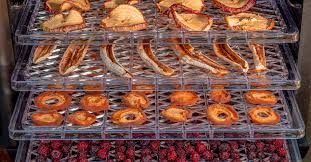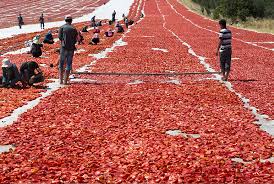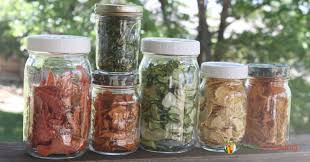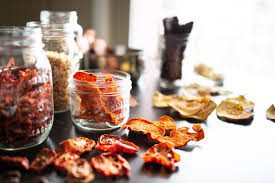Dehydration is a method of food preservation that involves removing moisture from food items to extend their shelf life. This process has been used for centuries to prevent spoilage and is still widely used today, especially in households and the food industry.
Dehydration reduces water content in foods, making it difficult for bacteria, yeast, and mold to grow. It’s an efficient and affordable way to preserve food while retaining its nutritional value.
Importance of Moisture Removal in Food Preservation
Moisture plays a critical role in the spoilage of food. When foods contain high amounts of water, they become a breeding ground for microorganisms like bacteria, mold, and fungi. These microorganisms cause food to rot, lose flavor, and become unsafe to eat. Removing moisture through dehydration minimizes this risk by creating an environment where microorganisms cannot thrive.
By reducing water content:
1. Longer Shelf Life: Dehydration increases the storage period of foods by eliminating the conditions that support microbial growth.
2. Reduced Spoilage: Dehydrated foods are less likely to spoil compared to fresh produce.
3. Easy Storage: Dried foods take up less space and are lightweight, making them ideal for storage or transportation.
Types of Dehydration Methods

There are various dehydration methods that suit different needs and food types. Some of the most common include:
1. Sun Drying: Food is placed in direct sunlight to allow natural dehydration. Sun drying is a traditional method used for fruits and herbs, but it requires warm, dry weather.
2. Air Drying: This method uses natural air to remove moisture from foods. It is commonly used for herbs and flowers and can take place indoors or in a shaded outdoor area.
3. Oven Drying: In oven drying, food is placed in a conventional oven at low heat (usually around 140°F or 60°C) to remove moisture. This method is fast but requires constant monitoring to avoid over-drying.
4. Electric Dehydrator: A dehydrator uses low heat and fans to circulate air, speeding up the drying process. It’s an efficient method for dehydrating various foods like fruits, vegetables, and meat.
5. Freeze Drying: This advanced method involves freezing the food and then removing the water by sublimation (a process where ice turns into vapor without becoming liquid). Freeze drying preserves food quality but is more expensive and used mostly in commercial applications.
Benefits of Dehydrating Food
Dehydration offers numerous benefits, particularly for those interested in long-term food storage or reducing food waste. Here are some key advantages:
1. Preservation of Nutrients: Unlike other preservation methods like canning or freezing, dehydration retains most of the nutrients in food, especially vitamins and minerals.
2. Enhanced Flavor: Dehydration intensifies the natural flavors of food. For example, dried fruits like apples or mangoes become sweeter and more concentrated.
3. Cost-Efficient: Dehydrating food at home can save money, as it allows you to buy seasonal produce in bulk and preserve it for later use.
4. Space Saving: Dehydrated foods take up less space than fresh foods, making them easier to store in small pantries or even pack for travel.
5. Easy Rehydration: Dried foods can be rehydrated by soaking them in water, making them versatile for cooking in various dishes.
Read Also: Reasons why Your Fishes Don’t Grow
Common Foods Suitable for Dehydration

Many different types of foods are ideal candidates for dehydration. Here are some of the most commonly dehydrated foods:
1. Fruits: Apples, bananas, grapes (for raisins), mangoes, and strawberries are all popular choices due to their natural sweetness and flavor retention.
2. Vegetables: Carrots, tomatoes, peppers, and mushrooms can be dehydrated for soups, stews, and snacks.
3. Herbs: Basil, oregano, thyme, and mint are often dried for use in cooking, as dried herbs retain their flavor for months.
4. Meat: Beef jerky and other dried meats are popular among campers and hikers because they are lightweight and packed with protein.
5. Grains: Rice and grains like quinoa can be dehydrated and stored for long periods.
6. Dairy: Dairy products such as yogurt and cheese can be dehydrated to create powdered forms that are easy to store and use in various recipes.
7. Nuts and Seeds: Almonds, walnuts, and sunflower seeds can be dried for extended shelf life and a more concentrated flavor.
How Dehydration Extends Shelf Life
Dehydration significantly extends the shelf life of food by removing moisture, which is essential for the growth of microorganisms like bacteria, mold, and yeast. These organisms thrive in moist environments, leading to food spoilage. When moisture is reduced to around 10-20%, food becomes less susceptible to microbial growth, and the enzymatic reactions that cause deterioration slow down.
By lowering water content:
1. Slows Microbial Growth: Dehydration creates conditions where harmful bacteria cannot survive, preventing spoilage and keeping food safe for consumption.
2. Reduces Chemical Reactions: Many chemical reactions that cause spoilage, like oxidation, slow down without water, preserving the freshness and nutrients.
3. Maintains Nutritional Value: Dehydration retains most vitamins and minerals, ensuring the food remains nutritious even after months of storage.
Steps to Dehydrate Food at Home
Dehydrating food at home is a straightforward process, and it can be done using a few simple methods. Here’s a step-by-step guide to get started:
1. Select Fresh Produce: Choose fruits, vegetables, or meats that are fresh and ripe. Avoid items that are bruised or overripe, as they may not dehydrate well.
2. Wash and Prepare the Food: Clean the food thoroughly to remove any dirt or pesticides. Peel, slice, or chop fruits and vegetables evenly to ensure they dehydrate at the same rate.
3. Pre-Treatment (Optional): Some foods, like apples and bananas, may benefit from pre-treatment to preserve color and flavor. This could include soaking in lemon juice or blanching vegetables like carrots.
4. Choose Your Dehydration Method:
i. Sun Drying: Place the food on drying racks in a sunny, dry area with good air circulation.
ii. Oven Drying: Set your oven to a low temperature (around 140°F or 60°C) and spread the food on baking sheets.
iii. Dehydrator: Set the dehydrator at the recommended temperature for the food you’re drying, and allow it to run for the suggested time.
5. Monitor Drying Time: Different foods have varying dehydration times. For example, fruits can take anywhere from 6 to 12 hours, while vegetables may take less time. Meats for jerky typically take 4-6 hours in a dehydrator.
6. Test for Doneness: Check if the food is adequately dried by feeling it. It should be leathery but not brittle. For fruits, there should be no moisture left, but they should remain pliable.
7. Cool and Store: Once the food is dry, let it cool completely before storing it in airtight containers or vacuum-sealed bags.
Commercial Dehydration Techniques
In commercial settings, dehydration is done on a larger scale with more advanced equipment and methods. Some common commercial techniques include:
1. Spray Drying: Used mainly for liquids like milk or fruit juice. The liquid is sprayed into a hot air chamber, turning it into powder almost instantly.
2. Freeze Drying: Foods are first frozen, and then moisture is removed by sublimation. This process retains food structure and flavor better than other methods and is used for high-value products like coffee, herbs, and certain fruits.
3. Drum Drying: Food slurry is spread over a rotating heated drum. As the drum rotates, moisture evaporates, and the food dries into flakes or powder.
4. Vacuum Drying: Food is dried under reduced pressure, which allows it to dehydrate at lower temperatures, preserving its quality. This method is often used for delicate foods like vegetables and fruits.
Read Also: The Best Stage to Start Raising your Catfishes (Fingerlings or Juveniles)
Packaging and Storing Dehydrated Foods

Proper packaging and storage are essential to ensure that dehydrated foods remain safe and edible for an extended period. Here are some key steps:
1. Use Airtight Containers: Dehydrated foods must be stored in airtight containers such as glass jars, plastic containers, or vacuum-sealed bags to prevent moisture from entering.
2. Store in a Cool, Dark Place: Heat and light can cause food to spoil more quickly. Keep dehydrated food in a cool, dark pantry or cupboard to extend its shelf life.
3. Use Desiccants or Oxygen Absorbers: These can be added to storage containers to absorb any residual moisture or oxygen, keeping the food dry and fresh.
4. Label Containers: Clearly label each container with the date of dehydration and the contents, so you know when to use them and avoid waste.
5. Regularly Check for Spoilage: Inspect stored food periodically for signs of spoilage, such as moisture build-up, mold, or changes in texture or color.
Challenges of Dehydrating Food
While dehydration is a fantastic way to preserve food, it also comes with some challenges:
1. Uneven Drying: If food pieces are not uniformly cut or placed in the dehydrator, they may dry unevenly, leading to some sections being over-dried and others remaining moist, which increases the risk of spoilage.
2. Loss of Some Nutrients: While dehydration preserves many nutrients, some, like Vitamin C, may degrade during the drying process, especially in sun drying or oven drying.
3. Time-Consuming Process: Dehydration, particularly at home, can take a long time, often several hours or even days, depending on the method and food being dried.
4. Initial Cost of Equipment: Buying a dehydrator can be expensive, though it is a one-time investment that will pay off over time.
5. Rehydration Required for Some Foods: Certain dehydrated foods may need rehydration before they can be used in cooking, which adds an extra step to meal preparation.
6. Limited Food Types: Not all foods are suitable for dehydration. Foods with high-fat content, like avocados, or foods with very high moisture content, like watermelon, don’t dehydrate well.
Dehydration is a simple and effective method of food preservation that offers numerous benefits. By removing moisture from food, it extends shelf life, preserves nutrients, and reduces food waste.
With various methods like sun drying, oven drying, and freeze drying, dehydration is adaptable to different food types and preferences. Whether you’re preserving fruits, vegetables, or meats, dehydration is an excellent way to ensure that food lasts longer while maintaining its quality.
Do you have any questions, suggestions, or contributions? If so, please feel free to use the comment box below to share your thoughts. We also encourage you to kindly share this information with others who might benefit from it. Since we can’t reach everyone at once, we truly appreciate your help in spreading the word. Thank you so much for your support and for sharing!






